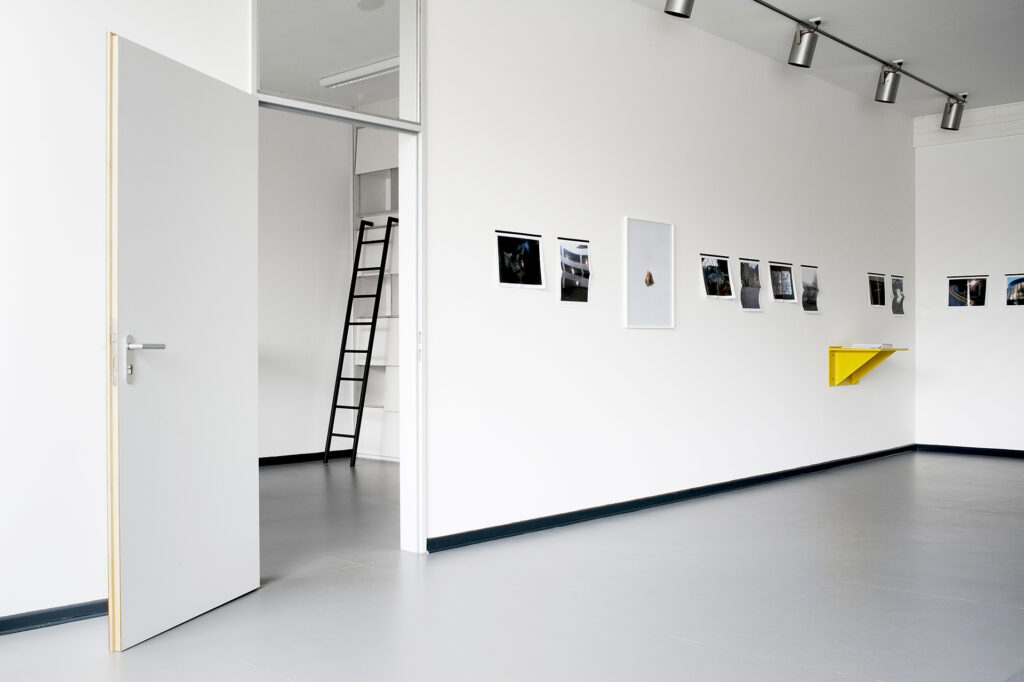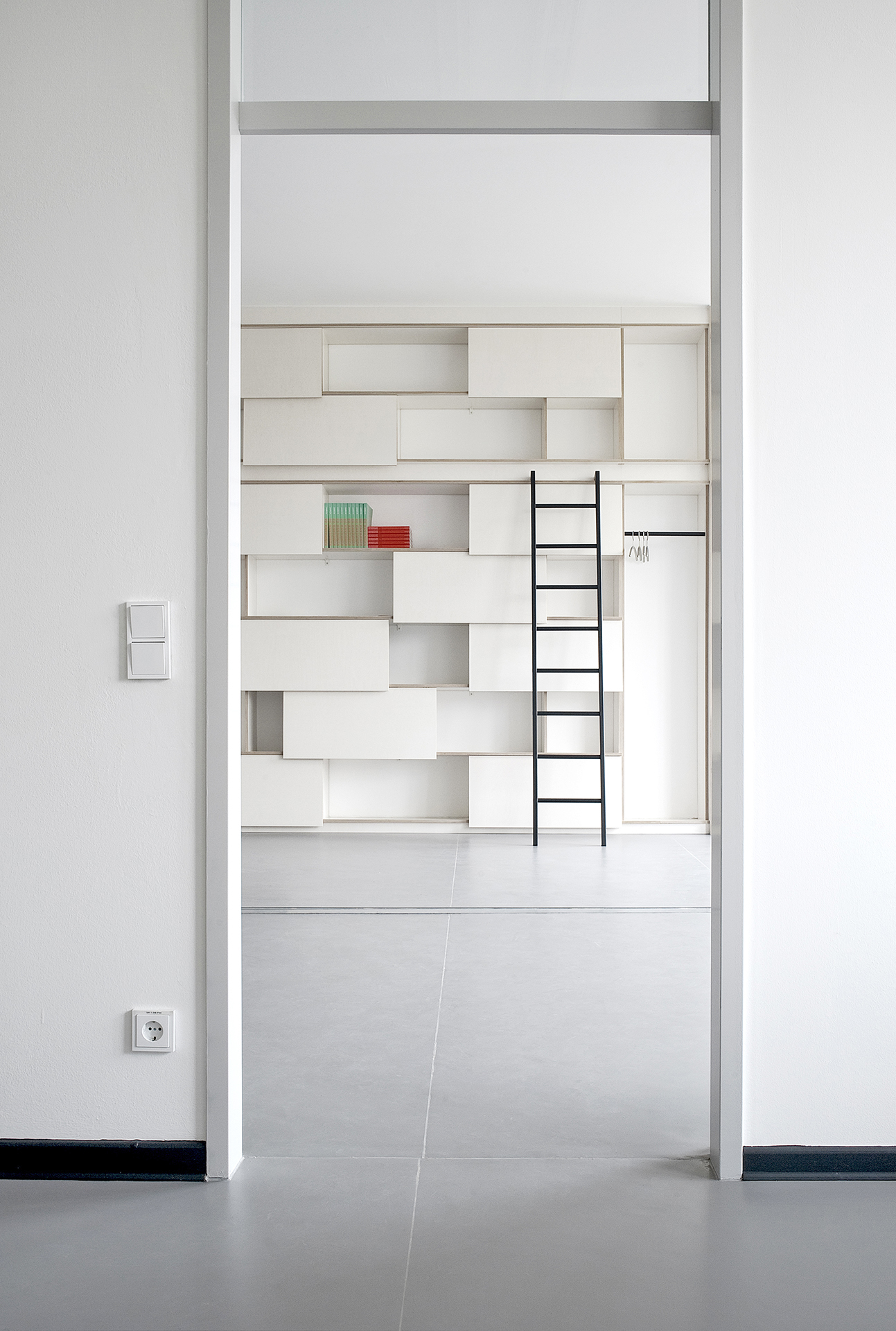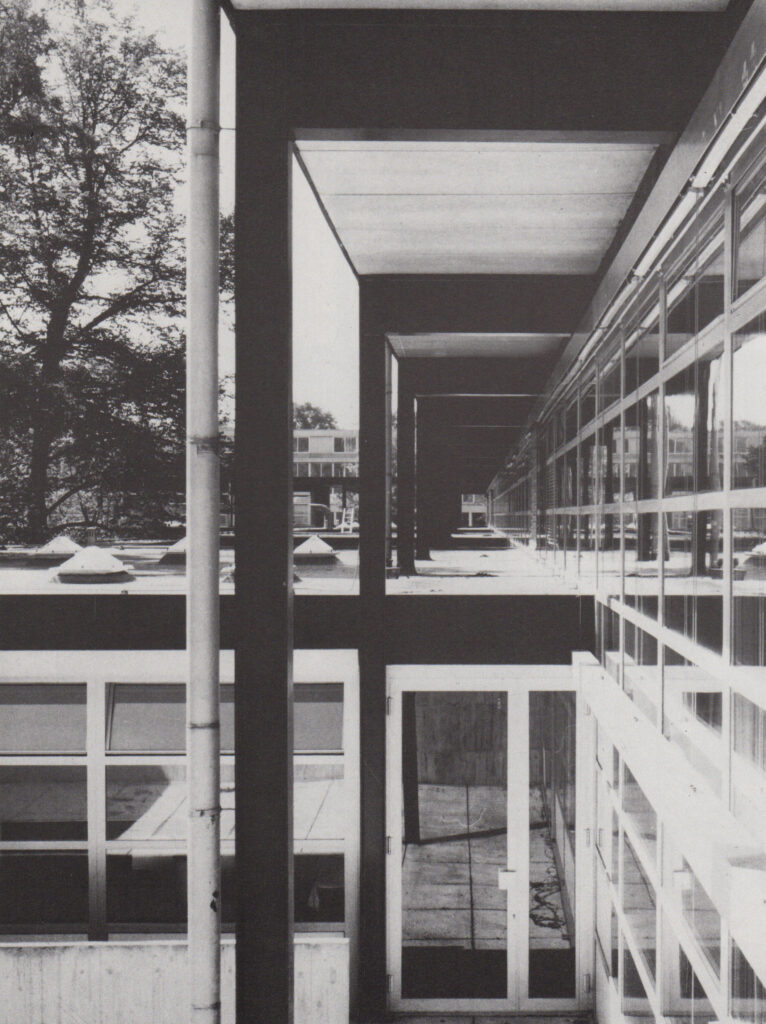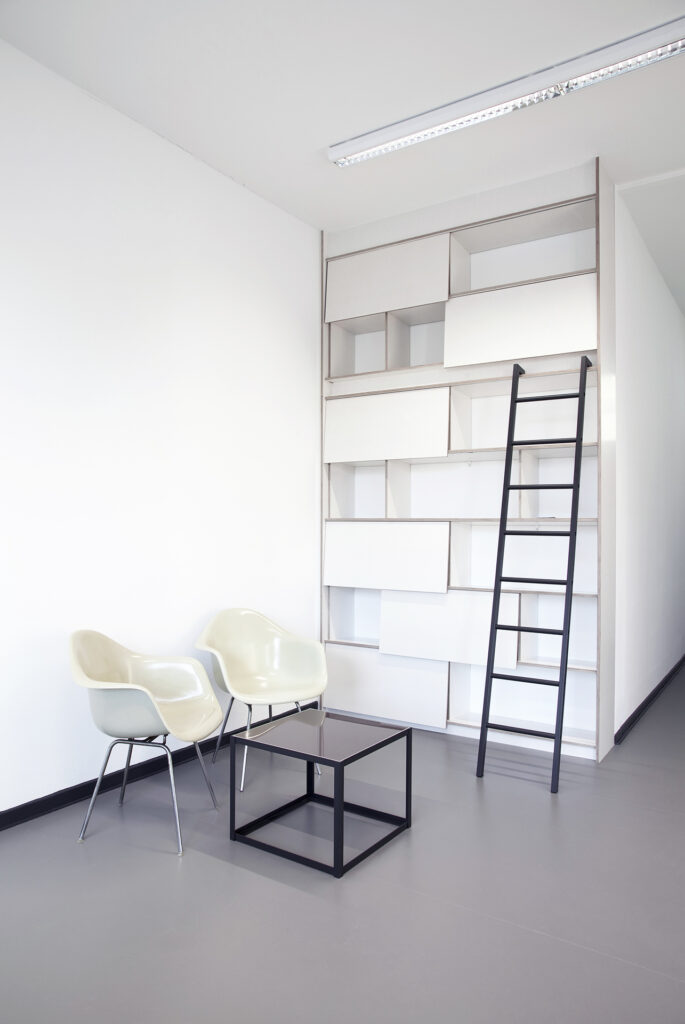
Rektorate

- Title Rektorate
-
Client
School of Art and Design
Kassel - Year 2012
-
Dimensions
100 m2
A Space for Dialogue: The rectorate in a new design. The newly designed dean’s office is meant to be a window, a forum, to make appear what moves the School of Art and Design Kassel.


The past, present and future of the School of Art and Design Kassel come together in the newly designed rooms. The result is a spacial ensemble of products, which have been conceptualized by Paul Friedrich Posenenske for the school already about 50 years ago. Among them are tables, lamps, cubes and couches.





The spirit and the concept behind Posenenske’s design are meant to be transmitted within these rooms: By this, the school of art and design is understood as a discursive space which presents the students and lecturers with an open structure on an architectural as well as artistic level.


Rektorate
2012
A Space for Dialogue: The rectorate of the School of Art and Design Kassel in a new design
Prof. Christian Phillip Müller assumed the rectorate’s office as dean of the School of Art and Design Kassel in August 2011 with many new ideas. In this spirit, his office space has also now been newly designed by graduated product designer and guest lecturer Hanna Krüger from Kassel.
Not only is the dean’s office of the School of Art and Design Kassel a place where important concepts are developed and where decisions are made. It is also meant to be a space for dialogue between the school’s administration, employees and students, as well as friends and sponsors of the School of Art and Design. In addition, Prof. Müller also opens the rooms as an exhibition space.
The open and transparent structure of the newly designed rooms reflects the transparency of the dean’s office with regards to content. The new format “Invited to the rectorate” will present small exhibitions from the work results of selected students and lecturers of the School of Art and Design.
The past, present and future of the School of Art and Design Kassel come together in the newly designed rooms. The result is a spacial ensemble of products, which have been conceptualized by Paul Friedrich Posenenske for the school already about 50 years ago. Among them are tables, lamps, cubes and couches. These were refined, reconstructed or reinterpreted by Hanna Krüger. Among other ideas, such as adapting former colours and materials, it has been a major issue to transform this design concept into the present. The transformation of the original design concept included the search for simple, yet precise materials, as well as clear-cut aesthetic and functional principles. The spirit and the concept behind Posenenske’s design are meant to be transmitted within these rooms: By this, the school of art and design is understood as a discursive space which presents the students and lecturers with an open structure on an architectural as well as artistic level. Hanna Krüger’s designs have then been realized by students at the school’s in-house studios.
In the dean’s office, historic elements face newly-developed designs. For example, a shelf system, which has been inspired by the proportions of former components, now produces a distinctly new impression. Sliding doors, like the shingles of a roof, are layered above each other in various different formations. One half of the shelf system consists of open surfaces, the other half of closed ones. By opening one, you close another. According to Hanna Krüger, “This is supposed to signify not only the school’s openness and transparency, but also its variability.”
One can also retrace the principle of the open framework, when looking at the design of the kitchen unit. It becomes alive especially during its utilization, by exposing every construction detail within the process. This design corresponds with various cubic frames, which have been designed by Posenenske for the School of Art and Design Kassel, drawing on the works of Ferdinand Kramer. These frames can be found within the structure of the whole school building. And within this architectonic structure you find prototypes from Krüger’s diploma project lined up: the glasslamp Vaiss.eau also transmits the idea of transparency, of the disclosure of its technical details and construction. Situated above a big table in the middle of the room, these lamps float like eluminated vessels, reflecting the importance of communication and dialogue within the rooms of the School of Art and Design. A strictly outlined work space with an executive chair is replaced by a mobile one. This not only makes mobility possible in spacial terms, but also in terms of encountering other people and ideas. As a result of this design, a skeleton-like structure emerges, which can be (re)animated, (re)appropriated and (re)used as a stage. Accordingly, the dean’s office is meant to be a window, a forum, to make appear what moves the School of Art and Design Kassel.
Press release School of Art and Design Kassel, February 13th 2012
Photographs: Minu Lee
Rektorate
2012
Raum des Dialogs: Rektorat der Kunsthochschule Kassel neu gestaltet
Nachdem im August 2011 Prof. Christian Philipp Müller mit vielen neuen Ideen das Amt des Rektors an der Kunsthochschule Kassel übernommen hatte, wurde nun das Rektorat auch räumlich neu gestaltet. Verantwortlich dafür zeichnet die diplomierte Kasseler Produktdesignerin und Dozentin Hanna Krüger.
Das Rektorat der Kasseler Kunsthochschule soll nicht nur ein Ort sein, wo wichtige Konzepte erarbeitet und Beschlüsse gefasst werden. Es soll ebenso ein Ort des Dialogs zwischen Hochschulleitung, Mitarbeitern und Studierenden untereinander sowie mit Freunden und Förderern der Kunsthochschule sein. Zudem öffnet Prof. Müller die Räumlichkeiten als Ausstellungsraum.
Die offene und lichte Struktur der neu gestalteten Räumlichkeiten reflektiert die inhaltliche Transparenz des Rektorats. Mit dem neuen Format „Zu Gast im Rektorat“ präsentieren künftig ausgewählte Studierende und Lehrende der Kunsthochschule ihre Arbeitsergebnisse in kleinen Ausstellungen.
In den neu gestalteten Räumen treten Geschichte, Gegenwart und Zukunft der Kunsthochschule Kassel in Beziehung zueinander. Es entsteht ein räumliches Ensemble aus Produkten, die vor ca. 50 Jahren von Paul Friedrich Posenenske für die Kunsthochschule entworfen wurden – darunter Tische, Leuchten, Kuben, Liegen. Hanna Krüger hat diese aufbereitet, rekonstruiert oder neu interpretiert. Auch Farben, Materialien und die Transformation der Gestaltungsidee von Posenenske in die heutige Zeit, wie z.B. in der Suche nach einfachen, aber präzisen Materialien oder in den klaren ästhetischen und funktionalen Strukturen, wurden aufgegriffen. Der Geist und das Konzept hinter den Entwürfen von Posenenske, die Kunsthochschule als einen diskursiven Ort zu begreifen, welcher den Studierenden und Lehrenden auf der baulichen und gestalterischen Ebene eine offene Struktur zur Verfügung stellt, soll in diesen Räumen weitergetragen werden. Kasseler Studierende haben in den hauseigenen Werkstätten die Entwürfe von Hanna Krüger umgesetzt.
Den historischen Elementen treten im Rektorat neu entwickelte Entwürfe gegenüber, beispielsweise ein Regalsystem, welches – inspiriert von den Proportionen vorhandener Einbauten – seinen ganz eigenen Ausdruck findet. Schiebetüren schichten sich in immer neuen Formationen wie die Schindeln eines Daches übereinander. Das Regalsystem besteht zur einen Hälfte aus offenen, zur anderen Hälfte aus verschlossenen Flächen. Öffnet man das eine, verschließt man das andere. „So sollen Offenheit, Transparenz, aber auch Wandelbarkeit an der Kunsthochschule signalisiert werden.“, betont Hanna Krüger.
Das Prinzip des offenen Gerüstes, welches erst durch seine Nutzung lebendig wird und alle konstruktiven Details offenlegt, findet sich auch in der Gestaltung der Küchenzeile wieder. Diese korrespondiert mit zahlreichen kubischen Gestellen, welche Posenenske mit Rückgriff auf Arbeiten Ferdinand Kramers für die
Kunsthochschule Kassel gestaltete und welche die Struktur des Gebäudes im Inneren fortsetzen. In diese architektonische Struktur reihen sich Prototypen aus Krügers Diplomarbeit ein: Die Glasleuchte Vaiss.eau fällt ebenfalls durch ihre Transparenz und die Offenlegung der technischen Details und der Konstruktion ins Auge. Diese Leuchten schweben wie erleuchtete Gefäße über einem großen Tisch in der Mitte des Raumes: ein Signal für den Wert der Kommunikation und des Dialogs in den Räumen der Kunsthochschule. Ein mobiler Arbeitsplatz ersetzt den festgeschriebenen Arbeitsplatz mit Chefsessel und ermöglicht Mobilität nicht nur räumlich sondern auch in der Begegnung. So entsteht mit dem Entwurf eine skelettartige Struktur, welche immer wieder neu belebt, verwendet und bespielt werden kann. Das Rektorat soll ein Fenster sein, eine Bühne bieten, um sichtbar werden zu lassen, was die Kasseler Kunsthochschule bewegt.
Fotos: Minu Lee
Pressemitteilung der Kunsthochschule Kassel vom 13. Februar 2012